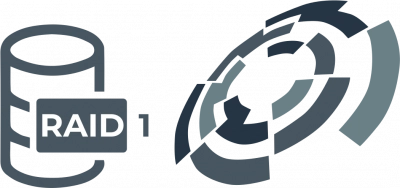Perform RAID 01 data recovery: what you need to know
Here you would find out:
- what is RAID0+1 array
- what are the data loss reasons in RAID0+1
- how to Prevent Data Loss
- is there any peculiarities in RAID01 data recovery
Are you read? Let's read!
What is RAID 0 + 1?
RAID 0 + 1 is an array level that uses RAID 0 (striping data) and RAID 1 (striping data by mirroring) for redundancy. That is, the data distribution mechanism is as follows: first, the data is striped across the hard drives, then the entire striping is mirrored.
To create such an array, an even number of disks is required and the minimum number of disks is 4. The read and write speed of this raid is excellent and is not inferior to RAID10. However, RAID 01 uses only half of its total capacity for storage, which in turn helps provide high fault tolerance, as the remaining half of the volume is dedicated to recovering from a disk failure. Your array can withstand more than one disk failure if they are not in the same mirrored set.
Since more than 4 disks are required to create a RAID 0 + 1, the cost of such an array will be significant. However, if fault tolerance is fundamental for you, then raid 0/1 is suitable for work in any area.
RAID 0 + 1 Data Loss Reasons
Despite its high fault tolerance, RAID 0 + 1 can still be damaged and data can be deleted, encrypted, or corrupted. All these reasons for array corruption can be grouped into several main groups:
- Accidental deletion of data. Often the human factor is to blame here, namely inattention.
- Damage to one or more hard drives. A hard drive can fail due to any system errors, bad sectors, or mechanical damage to the drive. In addition, you should always monitor the lifespan of your hard drive, as a worn out drive can die at any time.
- Server damage due to improper disconnection from the network, virus infection, common user errors, etc.
- Damage to the physical components of the server, such as the controller, motherboard, power supply and other important details.
How to Prevent Data Loss?
You can avoid losing data from an array, even if it is already damaged, by using the following helpful tips and tutorials.
- 1. If your array is damaged, do not use CHKDSK and other similar utilities. In this case, they may restore the disk, but they will certainly harm your data. You will permanently lose access even to the remaining files, as all files will be cut into pieces.
- 2. When repairing damaged disks and arrays yourself, most likely, you will simply delete all the information on them.
- 3. Make sure the disks in the array are in the correct order.
- 4. Always have a backup of your data, even if your array level is backed up. Don't kid yourself and your partners, no RAID is redundant.
- 5. Choose a RAID configuration according to your requirements. For example, if you have a lot of data, using RAID 0 would be pointless and dangerous since no disk can fail here.
- 6. Monitor the lifespan of your disks and always be prepared for the system to fail. If you have created a RAID based on the same vendor, or if all the disks in the array are from the same batch and production date, then they will most likely die at the same time. That is why it is necessary to check and monitor the health of hard drives at regular intervals.
- 7. Create an image of each disk, to increase the chances of data recovery. When doing so, label the disks in the correct order of their original state in the storage array to make it easier to restore the data striping order.
RAID 0 + 1 Data Recovery with DiskInternals
DiskInternals RAID Recovery will help you recover RAID 0 + 1 automatically - it seems unrealistic, but it really isn’t. This professional application is the flagship of the current year, as it has been improved by leading IT professionals and is constantly updated over the past 15 years.
The app has the popular free disk imaging feature, which can prevent future data loss. Of course, DiskInternals RAID Recovery recovers all common arrays well, and also automatically detects the original RAID type and provides full manual management. This is especially useful for professionals because you can track and control the recovery process.
The free preview is a great bonus in addition to the basic functions of the DiskInternals RAID Recovery app. You do not need to purchase a license here, this is an additional function that allows you to export recovered data and use technical support.
Here's what you need to do:
1. Install DiskInternals RAID Recovery on your computer. Open the application and launch the Recovery Wizard. Connect each RAID drive separately to your computer in the correct sequence.
2. The program automatically detects the available arrays and their characteristics - select the one you need.
3. Next, select the recovery mode and, after scanning, view the results for free. Then complete the whole process by exporting the data (Remember that you need a license for this).
Follow these simple and straightforward guidelines and you will succeed. Good luck!

